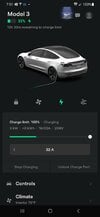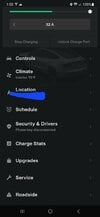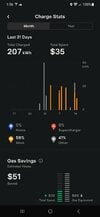I purchased my Model 3 about 3 weeks ago. I installed a level 2 Tesla charger at my home (this works perfectly, 7kW charge rate). I am fortunate enough to have an employer that has charging stations at work. At the campus I work at, there are about 20 charging stations (half ChargePoint, half Clipper Creek), all rated at 7.2kW, but use the J1772 charging plug. The first week that I had my car, I was receiving 6kW at these charging stations, using the J1772 adaptor. The charge stations do share electrical in pairs, so if both are in use I only get 3kW, which I am aware of this limitation but is not my issue.
After the first week, something happened where I am now only getting 3kW charge rate at any of the 20 stations. I confirmed my home charger still gave me 7kW charge rate, so I initially suspected an issue with my adaptor. I then drove my car to another campus that my employer has additional Clipper Creek charging stations, and I am able to get the full 6kW charge rate using my adaptor at these locations.
I spoke with a few other people that have EV's at my primary location, and came to find out the other Tesla drivers are having the same issue that I am, however the Kia and Chevy users at these locations were still getting 6kW charge rate.
I have opened up a support case with our facilities department, who reached out to both ChargePoint and Clipper Creek, but we are not arriving at any solutions. Has anyone else experienced this and have any recommendations? I have asked facilities if they can check to see if there are any firmware updates available, which they are looking into, but seems odd that both brands of chargers are having the same issue if its software related, however also odd that I can get full charge rate at another location using the same style charger, and non-teslas get full charge rate at my primary location.
After the first week, something happened where I am now only getting 3kW charge rate at any of the 20 stations. I confirmed my home charger still gave me 7kW charge rate, so I initially suspected an issue with my adaptor. I then drove my car to another campus that my employer has additional Clipper Creek charging stations, and I am able to get the full 6kW charge rate using my adaptor at these locations.
I spoke with a few other people that have EV's at my primary location, and came to find out the other Tesla drivers are having the same issue that I am, however the Kia and Chevy users at these locations were still getting 6kW charge rate.
I have opened up a support case with our facilities department, who reached out to both ChargePoint and Clipper Creek, but we are not arriving at any solutions. Has anyone else experienced this and have any recommendations? I have asked facilities if they can check to see if there are any firmware updates available, which they are looking into, but seems odd that both brands of chargers are having the same issue if its software related, however also odd that I can get full charge rate at another location using the same style charger, and non-teslas get full charge rate at my primary location.





